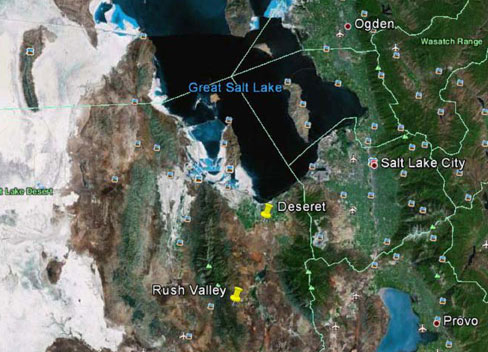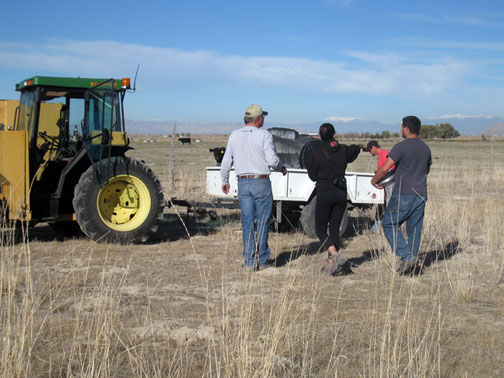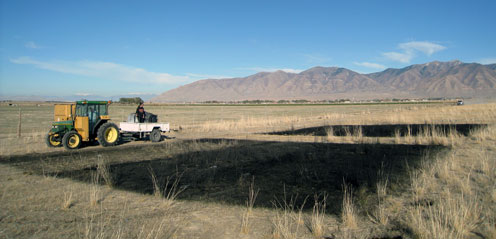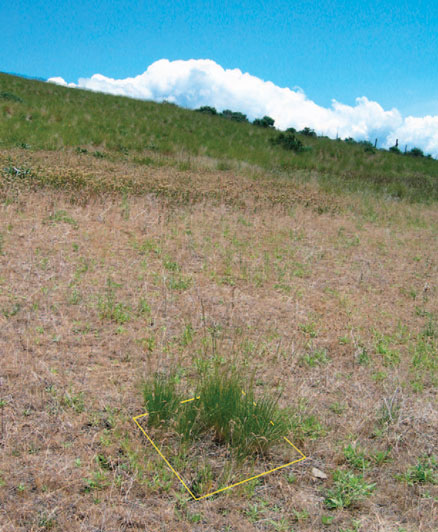Activated Carbon Helps Restore Native Plant Communities

Activated Carbon as a Restoration Technique in Utah
Non-native plants induce $100’s of millions of lost forage and management costs annually in the western US. Land managers need a cost effective method of restoring native plants and the ecosystem services they provide. Many of these sites are abandoned farmland, infested with weeds, simply reseeding these sites is often unsuccessful.
 The proposed research will test and refine a novel restoration approach, adding activated carbon (AC) to soil. AC has shown great promise in restoring native plants to shrubsteppe communities in small-scale applications.
The proposed research will test and refine a novel restoration approach, adding activated carbon (AC) to soil. AC has shown great promise in restoring native plants to shrubsteppe communities in small-scale applications.
Specific objectives: 1) test AC treatments at a larger scale than the one meter plots that have previously been used, 2) test different AC concentrations and types to identify the cheapest means of attaining native plant dominance in formerly weedy sites, and 3) understand how AC changes plant growth with the aim of developing a more targeted, effective and cheaper method of managing plant community restoration.
The project will take place in Tooele County. Specific sites are marked with yellow push pins in the map above.. Plots will be planted with: Indian ricegrass, bottlebrush squirreltail, western wheatgrass, bluebunch wheatgrass, tall wheatgrass, crested wheatgrass and Russian wildrye. Picture below show project participants in action.
 The proposed research: 1) fills a gap in understanding of why weeds become invasive, uses this information to control weeds, and restores ecosystem services provided by the native plant community, 2) evaluates tradeoffs of different management strategies, particularly concentrations of AC, and 3) describes how non-native plants cultivate disturbed soils in ways that increase their own growth and decrease the growth of natives.
The proposed research: 1) fills a gap in understanding of why weeds become invasive, uses this information to control weeds, and restores ecosystem services provided by the native plant community, 2) evaluates tradeoffs of different management strategies, particularly concentrations of AC, and 3) describes how non-native plants cultivate disturbed soils in ways that increase their own growth and decrease the growth of natives.
Interest in AC effects is growing rapidly. The proposed research will improve understanding of the mechanisms by which AC changes plant community development and the fundamental nature of plant-soil interactions.
More Information: Contact andrewkulmatiski@hotmail.com
Project Participants:
 Andrew Kulmatiski - Plants, Soils and Climate, USU
Andrew Kulmatiski - Plants, Soils and Climate, USU- Karen Beard - Wildland Resources, USU
- Nicole Nolan - MS Graduate Student, USU
- Linden Greenhalgh - USU County Extension Agent - Tooele County
- Jerry Caldwell and Bart Staples
I hate to make people learn new terms but there is no synonym for allelopathy. The definition below is specific to plants.
Allelopathy - one or more chemicals produced by a plant that influences the growth, survival, and reproduction of other plants. These chemicals are known as allelochemicals and can have beneficial or negative effects on other plants.
 Kulmatiski, A. and K. H. Beard. 2006. Activated Carbon as a Restoration Tool: Potential for Control of Invasive Plants in Abandoned Agricultural Fields. Restoration Ecology 14:251–257.
Kulmatiski, A. and K. H. Beard. 2006. Activated Carbon as a Restoration Tool: Potential for Control of Invasive Plants in Abandoned Agricultural Fields. Restoration Ecology 14:251–257.
Abandoned farmland is often infested with non-native plants and simply reseeding these sites is often unsuccessful. Non-native plants may use allelochemicals, positive plant–soil feedbacks, and may quickly acquire high concentrations of soil nutrients to out compete native plants. Adding activated carbon (AC) to the soil affects plant growth and may reduce certain soil microbes and bind allelochemicals.
In the laboratory, activated carbon (AC) reduces these advantages exhibited by non-native plants by binding to organic compounds. It is not known, however, if AC can effectively bind organics or reduce non-native plant growth under field conditions.
On soils dominated by weeds plants, we found:
- AC additions (1% AC by mass in the top 10 cm of soil) reduced concentrations of extractable organic C and N and changed plant community composition.
- Cheatgrass and diffuse knapweed cover decreased on AC plots (cheatgrass 14% to 8% and diffuse knapweed 4.0% to 0.1%) compared to control plots.
- The cover of native perennial grasses increased on AC plots (1.4–3.0% cover) compared to control plots.
- Unfortunately, some weeds, like prickly lettuce, responded positively to AC while some native plants responded negatively.
- AC addition did not result in native plant communities similar to undisturbed sites
- AC did demonstrate potential as a soil-based weed control tool, especially for cheatgrass and diffuse knapweed.
Seeding alone was not effective at restoring native plants, but adding AC to the soil and seeding restored native plant dominance. Thus, soil manipulations may be needed to restore native plant communities.
Andrew Kulmatiski. 2011. Changing Soils to Manage Plant Communities: Activated Carbon as a Restoration Tool in Ex-arable Fields. Restoration Ecology 19:102–110.
Due to its potential to inhibit plant–microbe interaction and allelopathy, there is a growing interest in the use of activated carbon (AC) as a soil manipulation for native plant restoration.
Here I describe the long-term effects of AC on native and non-native plant growth in the field and the short-term effects of AC on soil microbial communities.
Long-term effects of AC on native and non-native plants: AC (1% by mass) was added to soils in fields that had previously been farmed. Some plots were seeded with native seed while other were not seeded. Non-native plants dominated all sites.
Six years after a single application, AC plus seeding decreased non-native plants from 34 to 14% and increased native plants from 10 to 42%.
Short-term effects of AC on soil microbes: Compared to soils not treat with AC, soils treated with AC decreased the abundance of the bacterial, fungal, and mycorrhizal fats that are associated with soils dominted by non-native plants.
The effects of AC on plant growth might be due to its direct effects on heterotrophic, symbiotic, and pathogenic soil organisms as well as its ability to bind allelochemicals.
This research showed that soil manipulations may needed to restore native plant communities because seeding did not restore native plants, but AC plus seeding did restore native plant dominance.

